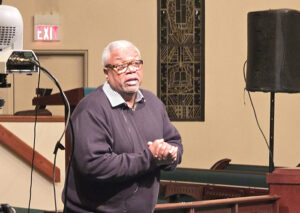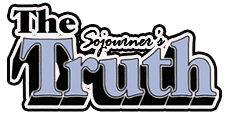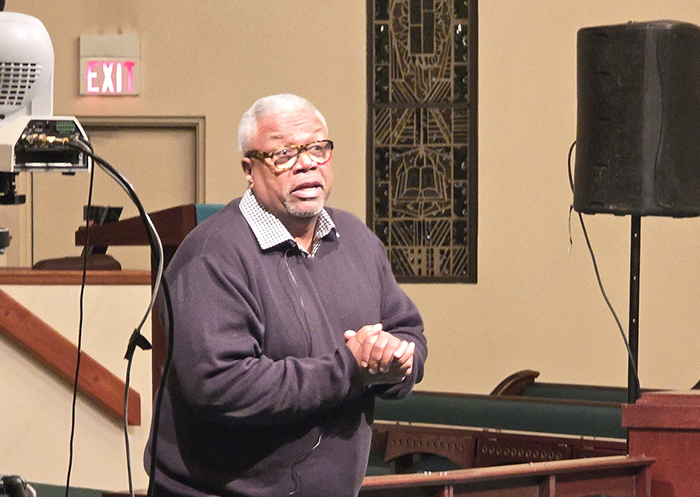
By Asia Nail
The Truth Reporter
Last week, Robert Smith, founder of the African American Legacy Project (AALP), sat down for an in-depth conversation with Boyce Safford III, a seasoned leader in urban development, former City of Columbus director of economic development and executive director of the Columbus Next Generation Corporation (NexGen). Over the course of an hour, Safford shared his experiences in community revitalization, strategies for fostering public-private partnerships, and insights on how Toledo can implement similar initiatives to transform its historic neighborhoods.
A Legacy of Transformation: Lessons from Columbus
Boyce Safford has played a critical role in shaping the landscape of Columbus’s urban renewal efforts, particularly in the King-Lincoln Bronzeville District. Once a thriving African American cultural and economic hub, the district faced severe decline over decades due to systemic disinvestment and urban planning decisions that displaced communities. Through strategic collaborations, Safford worked alongside former Columbus Mayor Michael Coleman and other civic leaders to breathe new life into the area.
One of the most striking aspects of Safford’s work is his ability to leverage major institutions—such as The Ohio State University and Nationwide Children’s Hospital—as active stakeholders in community revitalization. He recalled how these institutions sought city incentives, including tax abatements, and how Mayor Coleman used this as an opportunity to push for greater community engagement.
“We told them, ‘If you want something from the city, you have to give back to the people,’” Safford explained. The result was a comprehensive development plan that included affordable housing, improved healthcare access and an education pipeline designed to introduce local youth to careers in medicine.
The Power of Collaboration in Urban Development
Safford emphasized that no city government can single-handedly revitalize an entire district. “We created an advisory group called PACT,” he said, referring to a coalition of 30 community representatives who provided input on development plans. The goal was to ensure that revitalization efforts aligned with the needs of residents rather than simply serving outside developers. However, not all community leaders operated in good faith. “Some people claimed to represent a constituency, but they were really using their positions to block progress,” Safford noted. Over time, PACT evolved into a more effective entity, proving that inclusive planning is crucial for sustainable development.
Similarly, in Cincinnati, Safford highlighted how major corporations like Fifth Third Bank played a direct role in reshaping the Over-the-Rhine neighborhood. “The chairman of Procter & Gamble went to the mayor and said, ‘If we don’t clean this up, we’re moving out of downtown,’” Boyce recalled. This pressure led to nonprofit groups purchasing property and implementing strategic redevelopment initiatives. The lesson for Toledo? Businesses and universities must recognize their stake in neighborhood revitalization and actively participate in the process.
Dorr Street and Toledo’s Path Forward
During the discussion, Safford drew compelling parallels between Columbus’s King-Lincoln Bronzeville District and Toledo’s historic Dorr Street. Once the economic and cultural heartbeat of Toledo’s Black community, Dorr Street suffered a fate similar to King-Lincoln Bronzeville—disinvestment, displacement and neglect. However, Safford sees a path forward for Toledo if local leaders, institutions, and businesses commit to a shared vision.
“The University of Toledo needs to be engaged,” he asserted. “If major businesses and institutions don’t understand the impact of what’s happening on Dorr Street, they won’t be part of the solution.” He stressed that revitalization efforts must be a collaborative effort, with contributions from the city, county commission, school board, business leaders, and community organizations.
A crucial component of redevelopment, according to Safford, is land acquisition. In Columbus, the city has a well-established land bank that facilitates the transfer of abandoned and tax-delinquent properties for redevelopment. In contrast, Toledo primarily relies on a county land bank, which limits the city’s ability to rapidly repurpose vacant properties. “You have to ask, ‘Is that property behind on taxes? Who owns it? How do we get it into the hands of developers who will do the right thing?’” He explained.
Cultural Preservation and Economic Growth
Beyond infrastructure, Safford underscored the importance of preserving cultural institutions as anchors for revitalization. He shared how the Lincoln Theatre—a historic venue that once hosted jazz legends like Duke Ellington—was nearly demolished before community leaders intervened. The city invested $13 million into restoring the theater, turning it into a performing arts hub that continues to drive economic activity today.
“When we pitched the idea, people said, ‘Why do they need two theaters over there?’” Safford recalled. “But we knew that investing in cultural spaces was essential for long-term sustainability.” He envisions a similar opportunity for Toledo, where cultural districts can serve as economic engines by attracting tourism, business investments, and local talent.
He also spoke about the potential for coordinated arts and festival programming to bolster economic growth. “We need to bring together convention groups, create city-wide partnerships, and make these cultural districts self-sustaining,” he suggested. A thriving arts scene, coupled with strong business participation, could transform Toledo into a model city for urban renewal.
The Role of Political Will and Visionary Leadership
When asked whether the success of Columbus’s revitalization was solely due to Mayor Coleman’s dedication, Safford responded with a broader perspective. “Yes, it was his vision, but it could have been anyone’s vision,” he said. He cautioned against attributing progress solely to racial representation in leadership, arguing that sustained change requires structured plans, community involvement, and unwavering commitment.
“The city had to prove that investment in these communities made economic sense,” he explained. He pointed to areas like German Village in Columbus, where revitalization efforts were driven by historical preservation and economic incentives rather than race alone. Toledo, he believes, must adopt a similar strategy—demonstrating how investment in Black neighborhoods benefits the entire city.
Breaking Down Barriers to Progress
One of the key takeaways from the discussion was the need for authentic engagement between different sectors of the city. Safford described how community members in Columbus initially hesitated to support redevelopment efforts, fearing gentrification and displacement. “There’s always going to be someone in the room saying, ‘Whoo-wee, I don’t trust this,’” he said with a chuckle. However, he emphasized that these fears can be mitigated through transparency, community ownership and equitable policies.
His advice for Toledo? Build strategic coalitions, secure business partnerships, and push for policy changes that empower local communities. “Ask every stakeholder—University of Toledo, city officials, county commissioners, school boards—‘What are you bringing to the table?’” he urged.
Safford concluded with a powerful reminder: “This isn’t just about nostalgia for what once was. It’s about creating a sustainable future where history, culture and economic opportunity intersect.”
A Call to Action for Toledo
Boyce Safford’s conversation with Robert Smith serves as both a reflection on past successes and a blueprint for Toledo’s future. If the city embraces a collaborative, data-driven approach to urban renewal, it can reclaim its historic neighborhoods and set a precedent for inclusive development across the nation.
To achieve this, local leaders must recognize that revitalization is not just about buildings—it’s about people, culture and long-term economic empowerment. Whether through land acquisition, public-private partnerships or cultural preservation, Toledo has an opportunity to redefine its urban landscape for generations to come.
The question now is: Who will step up to lead the charge?
Watch the AALP Interview w/Boyce Strafford III here

